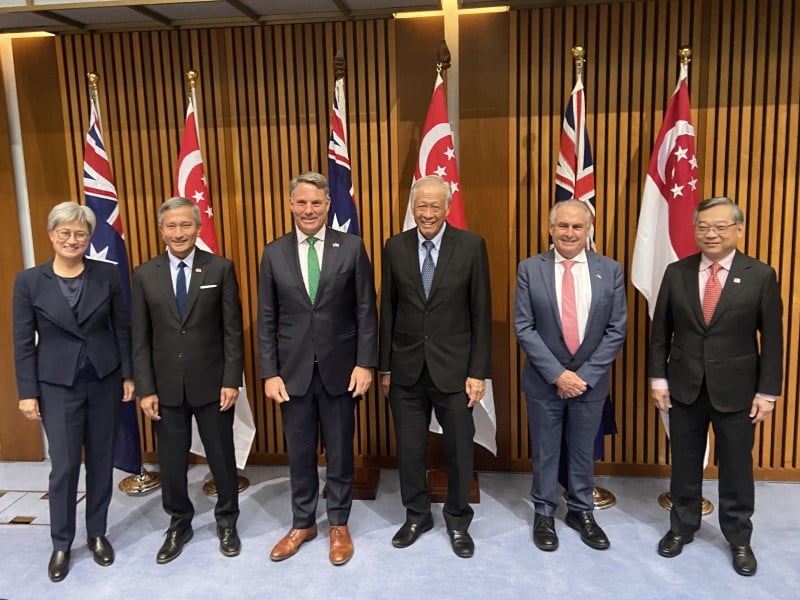Australia should lead Southeast Asia in pushing for green, bio and digital technology uptake as the international environment becomes increasingly multipolar, according to Singapore’s Foreign Minister Dr Vivian Balakrishnan.
Dr Balakrishnan also said ASEAN countries could overtake the European Union as Australia’s largest trading partner in time, mirroring what has already happened in China.
Singapore, meanwhile, is well placed to “host the advanced high-value added manufacturing operations and to serve as a supply chain control centre, and logistics and procurement hub for Australian businesses serving Southeast Asia”.

While in Canberra as a part of the 13th Singapore–Australia Joint Ministerial Committee meeting, Dr Balakrishnan spent his morning speaking at the Australian National University’s Southeast Asia Regional Geopolitical Update.
The committee is a platform for discussion on shared strategic, trade and investment interests, as well as cooperation across defence and security, the digital and green economies, food security, education, the arts, science and innovation.
Australia’s large reserves of critical minerals required to underpin the green and digital transformations, Dr Balakrishnan said, justifies his call that “Australia can and should take the lead in pushing for green, biotech and digital revolutions within Australia and in Southeast Asia and beyond”.
He also highlighted that the commencement of negotiations for an ASEAN digital economy framework agreement would help to “increase interoperability between Southeast Asia and Australia”.
As the United States and China remain “locked in perhaps one of the most intense competitions across multiple domains in our lifetimes”, the international strategic environment is moving towards an increasingly asymmetrical multipolar world, Dr Balakrishnan said.
“Both Australia and Singapore have concerns with major superpower rivalry, because we both know if this is unchecked, it leads on to the early signs of bifurcation and in fact to the weaponization of trade, supply chains, and even of money,” Dr Balakrishnan said.
He also noted that bifurcation will lead to a slower rate technological progress because “instead of the whole world working to improve a single technology stack that defines modern society, you now split into competing camps, working on different and… possibly incompatible systems of technology”.
Singapore can serve as a “welcome safe harbour for Australian companies and startups as they begin their first step of globalisation by making that step into Southeast Asia. In fact, I believe we have about 200 global and local accelerators in Singapore”, according to Dr Balakrishnan.
At a press conference following the joint ministerial meeting, Singaporean Trade and Industry minister Gan Kim Yong told InnovationAus.com that he is “very keen” to explore more opportunities to foster “collaboration with one another to better understand the market needs and to do product development”.
He highlighted that Enterprise Singapore has established several Global Innovation Alliances that seek to encourage innovation among small and medium-sized enterprises and foster international collaboration, including with Australia.
Last October, Industry and Science minister Ed Husic met with Mr Gan to help launch a synchrotron use agreement between the National University of Singapore and Australia’s Nuclear Science and Technology Organisation.
At the time, Mr Husic said the federal government should “think deeply about what we can do on global science diplomacy” and called for greater early-stage innovation collaboration between Singaporeans and Australians.
In financial year 2021, ASEAN was Australia’s second largest trading partner at $127.1 billion, while Trade with China totalled $267 billion. Singapore is Australia’s fifth largest trading partner.
In addition to the free trade agreement between Australia and Singapore, which reaches its 20th anniversary this week, the two countries have also signed a Digital Economy Agreement and a Green Economy Agreement, to support and accelerate development in these spaces.
“Singapore looks forward to working with Australia to support its ambition to be one of the top three exporters of hydrogen to Asia by 2030, and as we push ahead on clean energy and the digital and enhanced digital connectivity, I believe we can work together to improve the resilience of the subsea infrastructure,” Dr Balakrishnan said.
Do you know more? Contact James Riley via Email.

